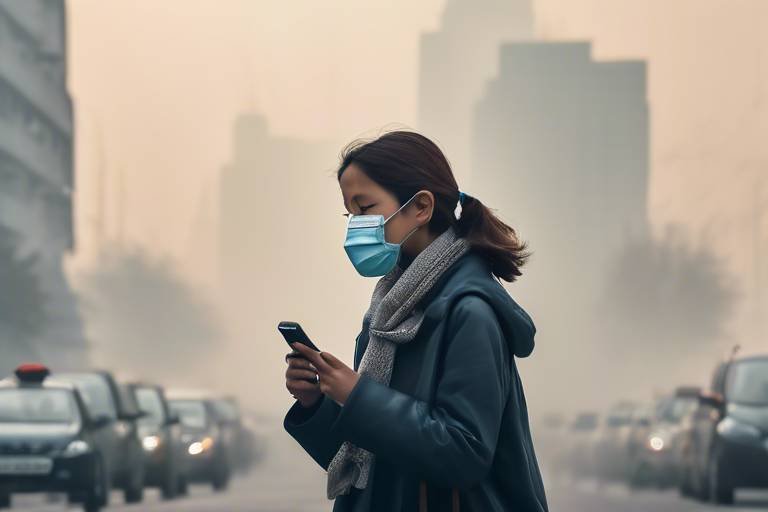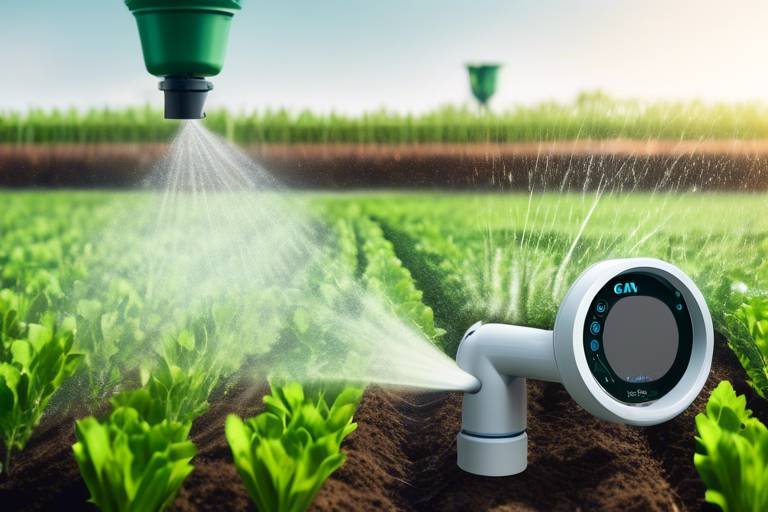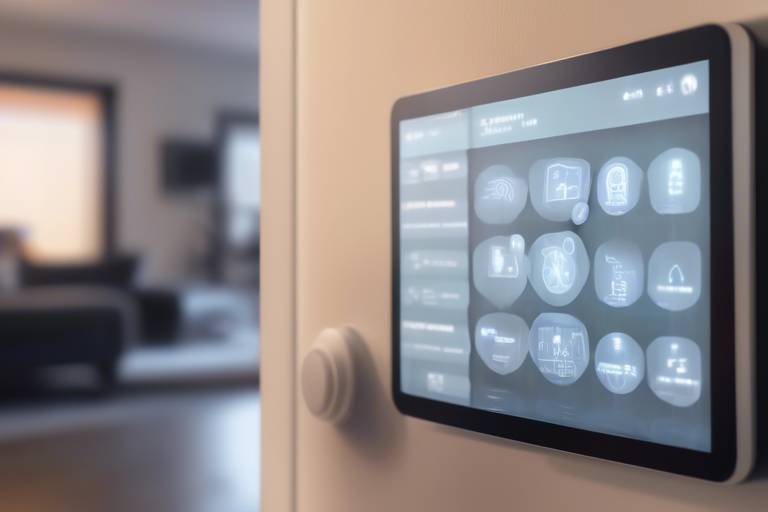The Role of AI in Fighting Air Pollution
Air pollution is one of the most pressing environmental challenges we face today. It affects our health, the ecosystem, and even the climate. But what if I told you that artificial intelligence (AI) is stepping in as a powerful ally in the fight against this invisible enemy? With its ability to analyze data, make predictions, and optimize processes, AI is transforming how we monitor and combat air pollution. Imagine a world where cities breathe easier, where the air is clean, and where technology helps us create a healthier environment for all. In this article, we will explore the various ways AI is revolutionizing air quality management and paving the way for a cleaner future.
One of the most significant advancements in combating air pollution is the development of AI-powered air quality monitoring systems. These systems leverage the immense capabilities of AI to analyze vast amounts of data collected from various sources, including satellites, sensors, and weather stations. By doing so, they provide real-time assessments of air quality and more accurate predictions of pollution levels. For instance, AI algorithms can sift through data and identify patterns that human analysts might miss, allowing for timely interventions when pollution levels spike.
Predictive analytics is another game-changer in the realm of air quality management. With the ability to forecast pollution trends and pinpoint potential sources of emissions, AI empowers policymakers to take proactive measures. Imagine being able to predict when and where pollution will be highest, enabling cities to implement traffic restrictions or issue health warnings before problems arise. This capability not only protects public health but also helps in crafting long-term strategies for pollution reduction.
At the heart of these predictive analytics are machine learning algorithms. These algorithms analyze complex pollution patterns and learn from historical data to make informed predictions. By understanding the factors that contribute to air quality degradation, researchers and policymakers can develop targeted strategies to effectively reduce air contaminants. For example, if an area shows a consistent rise in pollution during rush hour, traffic management solutions can be implemented to alleviate congestion and reduce emissions.
Advanced data collection techniques, such as remote sensing and the Internet of Things (IoT), further enhance the capabilities of AI systems. Remote sensing allows for the monitoring of air quality over large areas, while IoT devices can provide localized data from specific neighborhoods. The combination of these technologies ensures that AI systems have access to comprehensive and accurate environmental data, which is essential for effective air quality management.
AI also excels in simulating various pollution scenarios. By modeling different interventions, stakeholders can visualize the potential impacts of their decisions. For instance, if a city is considering implementing a new public transportation system, AI can simulate how this change would affect air quality. This insight allows decision-makers to make informed choices that prioritize both public health and environmental sustainability.
Imagine receiving a real-time alert on your smartphone about a sudden spike in air pollution in your area. AI systems are capable of generating such alerts, enabling communities to respond swiftly to pollution fluctuations. This is particularly vital for vulnerable populations, such as children and the elderly, who are at greater risk from poor air quality. Quick responses can include issuing health advisories or implementing temporary traffic restrictions to protect public health.
Integrating AI into urban planning processes is another powerful approach to reducing air pollution. City planners can leverage AI to design greener spaces, optimize traffic flow, and implement sustainable practices. By considering air quality in the planning stages, cities can create environments that promote healthier living.
AI-driven smart traffic management systems are revolutionizing how we handle urban traffic. By analyzing traffic patterns and adjusting signals accordingly, these systems can optimize vehicle flow, reduce congestion, and lower emissions. Think of it as a conductor leading an orchestra, ensuring that every vehicle plays its part in harmony to create a smoother, cleaner urban experience.
AI is also instrumental in planning and developing green infrastructure, such as parks and green roofs. These natural solutions not only enhance urban aesthetics but also absorb pollutants and improve air quality. By integrating nature into our cities, we can create a healthier environment for everyone.
Collaboration between AI technologies and government agencies is crucial for creating effective policies aimed at reducing air pollution. By working together, these entities can harness the power of data to inform regulations and initiatives that protect public health.
Data sharing initiatives between AI companies and government agencies foster transparency and enable better-informed decision-making. When both sectors collaborate, they can create comprehensive strategies for air quality management and pollution reduction. This partnership can lead to innovative solutions that benefit society as a whole.
AI can also play a role in designing targeted public awareness campaigns. By analyzing demographic data, AI can help create campaigns that educate citizens about air pollution and encourage community involvement in pollution reduction efforts. The more informed the public is, the more likely they are to take action to improve air quality.
- How does AI monitor air quality? AI monitors air quality by analyzing data from sensors, satellites, and weather stations to provide real-time assessments and predictions.
- Can AI predict pollution levels? Yes, AI uses predictive analytics to forecast pollution trends and identify potential sources of emissions.
- What role do machine learning algorithms play? Machine learning algorithms analyze complex pollution patterns and help develop targeted strategies for reducing air contaminants.
- How can AI improve urban planning? AI assists in designing greener spaces, optimizing traffic flow, and implementing sustainable practices to reduce air pollution.

AI-Powered Air Quality Monitoring
Artificial intelligence is revolutionizing the way we monitor air quality, transforming what was once a cumbersome and often inaccurate process into a streamlined, precise, and highly informative system. Imagine being able to assess the air you breathe in real-time, with data flowing in from various sources like weather stations, satellites, and even individual sensors placed on street corners. This is not just a dream—it's the reality that AI is bringing to our cities. By analyzing vast amounts of data, AI can provide a clearer picture of pollution levels, identifying hotspots and trends that previously went unnoticed.
One of the most exciting aspects of AI-powered air quality monitoring is its ability to deliver real-time assessments. Traditional methods often lagged in providing timely information, leaving communities vulnerable to sudden spikes in pollution. With AI, we can receive instant alerts about deteriorating air quality, enabling us to take immediate action. For instance, if a factory unexpectedly increases its emissions, AI can detect this change within minutes and notify local authorities and residents, allowing them to protect their health and well-being.
Moreover, AI systems can leverage machine learning algorithms to continuously improve their accuracy. These algorithms learn from historical data, identifying patterns and correlations that human analysts might overlook. This capability allows AI to not only assess current pollution levels but also to predict future trends. For example, by analyzing data from previous years, AI can forecast pollution spikes during specific events, such as traffic congestion during rush hour or increased emissions during industrial activity.
Additionally, AI can utilize advanced data collection techniques, such as remote sensing and Internet of Things (IoT) devices. These technologies work in tandem to gather comprehensive environmental data. Remote sensing satellites can monitor air quality over vast areas, while IoT sensors provide localized readings. When combined, they create a rich tapestry of information that AI can analyze for improved air quality management.
To illustrate the impact of AI in this field, consider the following table, which summarizes the key benefits of AI-powered air quality monitoring:
| Benefit | Description |
|---|---|
| Real-Time Monitoring | Provides immediate data on air quality fluctuations, allowing for quick responses. |
| Predictive Capabilities | Forecasts pollution trends based on historical data, enabling proactive measures. |
| Data Integration | Combines data from multiple sources for a comprehensive understanding of air quality. |
| Community Engagement | Empowers citizens with information, fostering awareness and involvement in pollution reduction. |
In conclusion, AI-powered air quality monitoring is not just a technological advancement; it’s a vital tool in our fight against air pollution. By harnessing the power of AI, we can create healthier environments and protect the well-being of our communities. As we continue to innovate and integrate AI into our air quality management strategies, the future looks promising for cleaner air and a healthier planet.

Predictive Analytics for Pollution Control
In the quest to combat air pollution, predictive analytics has emerged as a game-changer. Imagine having the ability to foresee air quality issues before they even occur! This is precisely what AI-powered predictive analytics offers. By leveraging vast datasets, AI can identify trends and patterns in pollution levels, allowing for timely interventions. For instance, if a city is experiencing a spike in vehicle emissions due to increased traffic, predictive models can forecast this surge based on historical data and current conditions. This foresight enables city planners and environmental agencies to take proactive measures to mitigate pollution before it escalates into a public health crisis.
One of the most compelling aspects of predictive analytics is its ability to pinpoint potential sources of pollution. By analyzing factors such as weather patterns, traffic data, and industrial activity, AI can help authorities identify specific areas that are at risk of exceeding safe air quality standards. This targeted approach is far more effective than broad, generalized strategies. For instance, if a particular neighborhood is identified as a hotspot for air pollution, local governments can implement stricter regulations on emissions or enhance public transportation options to reduce traffic congestion.
At the heart of predictive analytics are machine learning algorithms. These algorithms are designed to learn from data, continually improving their accuracy over time. They can analyze complex datasets to reveal intricate pollution patterns that might not be immediately apparent to human analysts. For example, a machine learning model could uncover that certain weather conditions—like high humidity combined with low wind speeds—correlate with increased smog levels. By understanding these relationships, policymakers can implement measures to address these conditions, such as promoting carpooling on days forecasted for poor air quality.
To feed these algorithms, advanced data collection techniques are crucial. Technologies such as remote sensing, satellite imagery, and Internet of Things (IoT) devices provide a wealth of information about air quality. These devices can monitor real-time pollution levels and send data to AI systems for analysis. The integration of this data allows for a more comprehensive understanding of the factors contributing to air pollution. For example, IoT sensors placed throughout a city can track emissions from vehicles and industrial sources, feeding this information back to predictive models that analyze trends over time.
Moreover, AI excels at modeling pollution scenarios. By simulating various interventions, stakeholders can visualize the potential impacts of different strategies on air quality. For instance, if a city is considering implementing a low-emission zone, AI can model the expected reduction in pollution levels based on traffic patterns and vehicle types. This simulation not only aids in decision-making but also helps in communicating the benefits of proposed measures to the public, fostering greater community support for environmental initiatives.
The ability to generate real-time alerts is another significant advantage of using predictive analytics in pollution control. AI systems can monitor air quality continuously and send immediate notifications to communities when pollution levels reach dangerous thresholds. This capability is vital for protecting vulnerable populations, such as children and the elderly, who may be more susceptible to the adverse effects of poor air quality. Quick responses can include issuing health advisories, adjusting traffic patterns, or even temporarily closing certain roads to reduce emissions during critical periods.
In summary, predictive analytics is revolutionizing the way we approach air pollution control. By harnessing the power of AI and machine learning, we can anticipate pollution trends, identify sources, and implement effective strategies to improve air quality. The integration of advanced data collection techniques and real-time monitoring systems not only enhances our understanding of pollution dynamics but also empowers communities to take proactive measures for a healthier environment.
- What is predictive analytics? Predictive analytics involves using statistical techniques and machine learning to analyze current and historical data to make predictions about future events.
- How does AI help in pollution control? AI helps in pollution control by analyzing large datasets to identify trends, forecast pollution levels, and recommend proactive measures to mitigate harmful emissions.
- What role do machine learning algorithms play? Machine learning algorithms analyze complex datasets to uncover patterns and relationships in pollution data, enabling targeted strategies for air quality improvement.
- How can communities benefit from real-time alerts? Real-time alerts allow communities to respond quickly to pollution spikes, protecting vulnerable populations and minimizing health risks.

Machine Learning Algorithms
Machine learning algorithms are at the forefront of the battle against air pollution, acting as the brain behind the data-driven decisions that can lead us to cleaner air. Imagine having a super-smart assistant that can sift through mountains of data faster than you can say "pollution." These algorithms analyze complex datasets to identify pollution patterns, trends, and sources, which are crucial for developing effective strategies to combat air contaminants. By using historical data combined with real-time inputs, machine learning can recognize patterns that would otherwise go unnoticed.
For instance, consider how machine learning can predict pollution levels based on various factors such as traffic flow, weather conditions, and industrial activity. It’s like having a crystal ball that not only shows you the current state of air quality but also forecasts future scenarios. This predictive capability allows researchers and policymakers to implement proactive measures before pollution levels reach critical thresholds, ultimately saving lives and improving public health.
To illustrate the power of machine learning in air quality management, let’s break down some of the key algorithms commonly utilized:
- Regression Analysis: This algorithm helps in predicting the concentration of pollutants based on various input factors, making it easier to assess the impact of different sources.
- Classification Algorithms: These algorithms categorize air quality data into different classes, helping to identify whether air quality is good, moderate, or poor.
- Clustering Techniques: By grouping similar data points, clustering algorithms can uncover hidden patterns in pollution sources, aiding in targeted interventions.
Moreover, machine learning algorithms are not just limited to identifying pollution sources; they can also assist in evaluating the effectiveness of pollution control measures. By analyzing data before and after the implementation of a new policy or technology, these algorithms can provide insights into what works and what doesn’t. This feedback loop is essential for continuous improvement in air quality management.
In conclusion, machine learning algorithms are indispensable tools that empower researchers and policymakers to make data-driven decisions in the fight against air pollution. By harnessing the power of AI, we can not only understand the complexities of pollution patterns but also take meaningful action towards a healthier planet.
Q1: How do machine learning algorithms improve air quality monitoring?
A1: Machine learning algorithms analyze vast amounts of data from various sources, enabling real-time assessments and accurate predictions of pollution levels.
Q2: Can machine learning predict future pollution levels?
A2: Yes, machine learning can forecast pollution trends based on historical data and real-time inputs, allowing for proactive measures to be taken.
Q3: What types of algorithms are commonly used in air quality management?
A3: Common algorithms include regression analysis, classification algorithms, and clustering techniques, each serving different purposes in understanding and managing air pollution.

Data Collection Techniques
In the fight against air pollution, the role of data collection techniques cannot be overstated. These methods form the backbone of artificial intelligence systems, enabling them to gather and analyze environmental data effectively. Imagine trying to solve a complex puzzle without all the pieces; that’s what tackling air pollution would be like without robust data collection. By leveraging advanced technologies, we can gain insights that were once thought impossible.
One of the most significant advancements in data collection is the use of remote sensing technology. This method employs satellites and aerial sensors to monitor air quality from a distance. By capturing images and data on pollutants, remote sensing provides a comprehensive view of pollution levels across large geographic areas. For instance, satellite data can reveal how industrial emissions affect air quality in urban centers, enabling targeted interventions.
Another game-changer is the integration of Internet of Things (IoT) devices. These smart sensors are installed in various locations, continuously measuring air quality parameters such as particulate matter, nitrogen dioxide, and ozone levels. The data collected by IoT devices is transmitted in real-time to central databases, allowing for immediate analysis and response. This real-time capability is crucial for timely public health warnings and policy adjustments. Here’s a quick overview of how these devices contribute:
- Accessibility: IoT devices can be placed in hard-to-reach areas, providing data from locations that traditional monitoring stations might miss.
- Granularity: They offer hyper-local data, giving insights into pollution hotspots within cities.
- Cost-Effectiveness: With prices dropping, deploying multiple IoT sensors is becoming more feasible for municipalities.
Moreover, mobile air quality monitoring is gaining traction. Equipped with sensors, vehicles can traverse urban landscapes, collecting data on-the-go. This approach not only provides a dynamic view of air quality but also helps identify pollution sources, such as traffic congestion or industrial discharges. By mapping these sources, city planners can implement more effective pollution control measures.
Finally, traditional methods still play a crucial role. Air quality monitoring stations, strategically located throughout urban areas, provide baseline data for long-term studies. These stations use sophisticated equipment to measure air quality indicators and are essential for validating the data collected by newer technologies. When combined with AI analytics, they enhance the accuracy of pollution forecasts and trends.
In summary, the synergy of remote sensing, IoT devices, mobile monitoring, and traditional stations creates a robust data collection framework. This comprehensive approach empowers AI systems to analyze pollution patterns effectively, making it possible to develop targeted strategies for cleaner air. As we continue to innovate in data collection techniques, we pave the way for a healthier environment and a brighter future.
- What is the most effective data collection technique for air quality monitoring? Each technique has its strengths, but a combination of remote sensing and IoT devices provides the most comprehensive data.
- How often is air quality data collected? It varies by method; IoT devices can provide real-time data, while traditional stations may report less frequently.
- Can AI help predict future air quality trends? Yes, AI uses historical data and current measurements to forecast future pollution levels, allowing for proactive measures.

Modeling Pollution Scenarios
Modeling pollution scenarios is a fascinating and essential part of understanding how air quality can be impacted by various factors. Imagine being able to visualize the effects of different interventions on air pollution levels before they are even implemented. This is precisely what AI-driven modeling offers! By simulating various scenarios, stakeholders can predict how changes in policies, urban planning, or even individual behaviors might influence air quality.
One of the most impressive aspects of AI in this context is its ability to process and analyze enormous datasets. These datasets can include everything from weather patterns and traffic data to industrial emissions and population density. By integrating these diverse data sources, AI can create highly accurate models that reflect real-world conditions. For instance, consider a city that is planning to implement a new public transportation system. AI can model how this change might reduce vehicle emissions and improve air quality, providing valuable insights for city planners.
Moreover, these models can help identify the most effective strategies for reducing pollution. For example, AI can simulate the impact of increasing green spaces, such as parks and urban forests, on air quality. The results can be compelling—showing how a few strategically placed trees can absorb pollutants and improve the overall air quality in a neighborhood. This kind of predictive capability not only informs decision-making but also helps in gaining public support for environmental initiatives.
To illustrate the potential of AI in modeling pollution scenarios, let’s look at a simple example:
| Scenario | Projected Air Quality Improvement | Estimated Cost |
|---|---|---|
| Implementing a new bus rapid transit system | 15% reduction in NO2 levels | $5 million |
| Increasing urban tree cover by 20% | 10% reduction in PM2.5 levels | $2 million |
| Introducing stricter vehicle emission standards | 25% reduction in CO2 levels | $1 million |
As shown in the table, different scenarios yield varying levels of air quality improvement and associated costs. This information is crucial for policymakers who must balance environmental goals with budget constraints. By utilizing AI to model these scenarios, cities can make informed, strategic decisions that maximize air quality benefits while minimizing costs.
In conclusion, modeling pollution scenarios through AI is not just about crunching numbers; it’s about envisioning a healthier future. It empowers cities and communities to make proactive choices that lead to cleaner air and a better quality of life. The ability to simulate and visualize outcomes is a game-changer in the fight against air pollution, making it an invaluable tool for anyone concerned about the environment.
- What is pollution modeling?
Pollution modeling involves using data and algorithms to simulate and predict how various factors affect air quality. - How does AI improve pollution modeling?
AI enhances pollution modeling by processing large datasets quickly and accurately, allowing for more precise predictions. - Can pollution models help in policy-making?
Absolutely! These models provide valuable insights that can guide policymakers in creating effective environmental regulations. - What types of data are used in pollution modeling?
Data can include traffic patterns, industrial emissions, weather data, and demographic information.

Real-Time Alerts and Responses
In today's fast-paced world, air quality can change in the blink of an eye, affecting our health and well-being. This is where real-time alerts powered by artificial intelligence come into play. Imagine waking up to a beautiful sunny day, only to discover that the air quality has suddenly taken a nosedive due to unforeseen pollution spikes. With AI systems monitoring air quality continuously, communities can receive immediate alerts about these fluctuations, allowing them to take swift action. This technology not only empowers individuals but also helps local authorities respond effectively to air quality issues.
AI-driven systems utilize a network of IoT devices, including sensors placed throughout urban areas, to gather real-time data on air pollutants. When pollution levels exceed safe thresholds, these systems can send alerts via mobile apps, social media, or even local news broadcasts. For instance, if a factory unexpectedly releases harmful emissions, the AI can detect the increase in pollutants and notify residents in real-time. This rapid response capability is crucial for protecting vulnerable populations, such as children, the elderly, and those with pre-existing health conditions.
Moreover, the integration of AI in air quality monitoring allows for a more nuanced understanding of pollution sources. By analyzing patterns in the data, AI can identify not just when pollution spikes occur, but also where they originate. This information is invaluable for local governments and environmental agencies as they can implement targeted measures to mitigate these issues. For example, if a particular area consistently shows high levels of nitrogen dioxide, authorities can investigate the sources and take action, whether it be regulating traffic flow or enforcing stricter emissions standards.
To illustrate the impact of real-time alerts, consider the following table that outlines the benefits of AI-driven air quality monitoring systems:
| Benefit | Description |
|---|---|
| Immediate Notifications | Alerts residents about sudden changes in air quality, allowing for quick protective measures. |
| Data-Driven Insights | Provides valuable information on pollution sources, aiding in effective policy-making. |
| Community Engagement | Encourages public participation in air quality management through awareness and education. |
| Health Protection | Helps safeguard vulnerable populations by providing timely information on health risks. |
In essence, the role of AI in providing real-time alerts and responses to air quality issues cannot be overstated. It transforms the way we interact with our environment, making us more aware and proactive in protecting our health. As cities continue to grow and pollution becomes an increasingly pressing issue, the integration of AI technologies will play a pivotal role in ensuring cleaner air and healthier communities.
- How does AI monitor air quality?
AI monitors air quality by analyzing data from various sensors and IoT devices, providing real-time insights into pollution levels and sources.
- What are the benefits of real-time alerts?
Real-time alerts help communities respond quickly to pollution spikes, protect vulnerable populations, and inform policy decisions.
- Can AI predict future pollution levels?
Yes, AI uses predictive analytics to forecast pollution trends based on historical data and current conditions.
- How can individuals get involved in air quality management?
Individuals can stay informed through AI-generated alerts and participate in community initiatives aimed at reducing pollution.

AI in Urban Planning
Integrating artificial intelligence into urban planning is nothing short of revolutionary. Imagine a city where traffic flows smoothly, parks are strategically placed for maximum benefit, and pollution levels are kept at bay—all thanks to the power of AI. This technology is not just a futuristic dream; it’s a reality that city planners are starting to embrace. By leveraging AI, urban planners can create environments that not only enhance the quality of life for residents but also promote sustainability.
One of the most significant advantages of using AI in urban planning is its ability to analyze vast amounts of data quickly and accurately. For instance, AI can process data from traffic patterns, weather conditions, and even social media trends to understand how different factors contribute to air pollution. This data-driven approach allows planners to make informed decisions that can significantly reduce the environmental impact of urban areas.
Moreover, AI can help design green spaces that serve multiple purposes. Parks, community gardens, and green roofs are not just aesthetic enhancements; they play a crucial role in absorbing pollutants and improving air quality. By utilizing AI algorithms, planners can identify the best locations for these green infrastructures, ensuring they are effective in mitigating pollution while also providing recreational spaces for the community.
Another exciting application of AI in urban planning is smart traffic management. Traditional traffic systems often struggle to adapt to real-time conditions, leading to congestion and increased emissions. However, AI-driven systems can analyze traffic flow and adjust signals dynamically, optimizing vehicle movement and reducing idle times. This not only lowers emissions but also enhances the overall commuting experience for residents. For example, cities using AI to manage traffic have reported a significant decrease in congestion and a corresponding improvement in air quality.
As cities continue to grow and evolve, the need for sustainable urban planning becomes even more critical. AI can assist in simulating various urban scenarios, allowing planners to visualize the potential impacts of different interventions. By modeling pollution scenarios, stakeholders can see firsthand how changes in traffic patterns, the introduction of green spaces, or even alterations to building designs can affect air quality. This proactive approach empowers decision-makers to implement strategies that prioritize public health and environmental sustainability.
In summary, the integration of AI in urban planning is paving the way for smarter, cleaner, and more sustainable cities. By harnessing the power of data analysis and predictive modeling, urban planners can create environments that not only enhance the quality of life for residents but also contribute to a healthier planet. The future of urban living is bright, and AI is at the forefront of this transformation.
- How does AI improve air quality in urban areas?
AI improves air quality by analyzing data from various sources to monitor pollution levels, predict trends, and suggest mitigation strategies.
- What role does smart traffic management play in reducing emissions?
Smart traffic management systems optimize vehicle flow, reduce congestion, and lower emissions by adjusting traffic signals based on real-time data.
- Can AI help in planning green spaces?
Yes, AI can identify optimal locations for parks and green roofs, ensuring they effectively absorb pollutants and enhance urban air quality.
- What are the benefits of modeling pollution scenarios?
Modeling pollution scenarios allows planners to visualize the effects of different interventions, enabling informed decision-making for air quality regulations.

Smart Traffic Management
In today's fast-paced urban environments, managing traffic effectively is crucial for reducing air pollution and enhancing the quality of life for residents. systems, powered by artificial intelligence, are revolutionizing how cities handle vehicle flow and congestion. Imagine a city that can adapt in real-time, adjusting traffic signals based on the actual flow of vehicles. This is not just a dream; it's becoming a reality thanks to AI technology.
At the heart of smart traffic management lies the ability to analyze vast amounts of data from various sources, such as traffic cameras, road sensors, and even social media feeds. By leveraging machine learning algorithms, these systems can predict traffic patterns, identify bottlenecks, and suggest optimal routes for drivers. For instance, if a major intersection is experiencing heavy traffic, the system can automatically extend the green light duration or reroute traffic to less congested roads, thereby minimizing idling time and reducing emissions.
Furthermore, these AI-driven systems can incorporate real-time data from public transportation networks. By synchronizing traffic signals with bus and train schedules, cities can ensure that public transport is not held up by car congestion. This not only enhances the efficiency of public transit but also encourages more people to opt for these greener alternatives, further decreasing the number of vehicles on the road.
To illustrate the impact of smart traffic management, consider the following table that showcases potential benefits:
| Benefit | Description |
|---|---|
| Reduced Congestion | AI systems optimize traffic flow, leading to fewer traffic jams and smoother commutes. |
| Lower Emissions | By minimizing stop-and-go traffic, vehicles emit fewer pollutants into the atmosphere. |
| Enhanced Public Safety | Improved traffic management reduces the likelihood of accidents and promotes safer roadways. |
| Increased Efficiency | Real-time adjustments save time for drivers and public transport users alike, leading to a more efficient transportation system. |
Moreover, smart traffic management isn't just about technology; it's about creating a sustainable future. By integrating AI with urban planning, cities can design road networks that prioritize pedestrian pathways, bicycle lanes, and green spaces. This holistic approach not only curtails air pollution but also fosters a healthier lifestyle for residents.
In conclusion, smart traffic management powered by AI is a game-changer in the fight against air pollution. By optimizing vehicle flow and encouraging the use of public transport, these systems are paving the way for cleaner air and a more sustainable urban environment. Isn't it fascinating to think about how technology can enhance our daily lives and contribute to a healthier planet?
- What is smart traffic management? Smart traffic management refers to the use of AI and data analytics to optimize traffic flow and reduce congestion in urban areas.
- How does AI help in traffic management? AI analyzes real-time data from various sources to predict traffic patterns, adjust signals, and suggest alternative routes to minimize congestion and emissions.
- What are the benefits of smart traffic systems? Benefits include reduced congestion, lower emissions, enhanced public safety, and increased overall efficiency in transportation.
- Can smart traffic management improve public transportation? Yes, by synchronizing traffic signals with public transport schedules, smart systems can enhance the efficiency and reliability of public transit.

Green Infrastructure Development
As cities expand and urbanize, the concept of green infrastructure has emerged as a pivotal strategy in the fight against air pollution. This approach emphasizes the importance of integrating natural systems into urban planning to create spaces that not only beautify our surroundings but also serve essential environmental functions. Imagine a city where every park, green roof, and tree-lined street works together to filter the air we breathe. This is not just a dream; it's a reality that artificial intelligence (AI) is helping to shape.
AI plays a crucial role in the development of green infrastructure by providing insights that lead to better planning and implementation. For instance, AI algorithms can analyze data on air quality, weather patterns, and urban heat islands to identify the most effective locations for planting trees or creating green spaces. By doing so, cities can maximize the benefits of these initiatives, ensuring that they effectively reduce airborne pollutants while enhancing the quality of life for residents.
Moreover, the integration of AI in green infrastructure development allows for a more dynamic approach to urban planning. Instead of relying on static models, AI can simulate various scenarios, helping planners visualize the impact of different green initiatives. For example, a city might use AI to model the effects of adding a new park in a heavily polluted area. By analyzing data on traffic patterns, existing vegetation, and pollution sources, AI can predict how much pollution the park could potentially absorb, thereby informing decision-makers about its viability.
Another exciting aspect of green infrastructure development is the potential for community engagement. AI can facilitate public participation by providing platforms for residents to voice their opinions and preferences regarding green projects. With tools like interactive maps and data visualization, community members can better understand how proposed green spaces will impact their neighborhoods. This not only empowers citizens but also fosters a sense of ownership and responsibility towards maintaining these vital resources.
In addition to parks and trees, green roofs represent another innovative application of green infrastructure. These living roofs can significantly improve air quality by filtering pollutants and providing insulation, which reduces energy consumption. AI technologies can assist in the design and maintenance of these roofs by monitoring plant health and environmental conditions, ensuring that they remain effective over time.
In summary, the development of green infrastructure is a multifaceted approach that combines natural systems with cutting-edge technology. Through AI, cities can create greener, healthier environments that combat air pollution while enhancing urban livability. The collaboration between urban planners, environmental scientists, and AI experts is essential in realizing this vision, paving the way for a sustainable future where clean air is a fundamental right for all.
- What is green infrastructure?
Green infrastructure refers to a network of natural and semi-natural features, such as parks, green roofs, and urban forests, that provide environmental benefits and enhance urban resilience. - How does AI contribute to green infrastructure?
AI helps analyze data to identify optimal locations for green projects, simulate their impacts, and engage communities in the planning process. - What are the benefits of green roofs?
Green roofs improve air quality, provide insulation, reduce stormwater runoff, and enhance urban biodiversity. - Can green infrastructure help combat climate change?
Yes, by reducing urban heat, improving air quality, and enhancing carbon sequestration, green infrastructure plays a significant role in climate change mitigation.

Collaboration Between AI and Government Agencies
In the battle against air pollution, the collaboration between artificial intelligence technologies and government agencies has emerged as a critical alliance. This partnership is not merely about technology; it represents a convergence of innovation, policy-making, and public health initiatives. By working together, AI developers and government officials can leverage advanced data analytics to create more effective strategies for air quality management. Imagine a scenario where data from sensors spread across a city is analyzed in real-time, allowing authorities to respond to pollution spikes almost instantaneously. This is the power of AI in action.
One of the most significant aspects of this collaboration is the establishment of data-sharing initiatives. By pooling resources and information, AI companies and government agencies can foster transparency and enhance decision-making processes. This synergy allows for the identification of pollution sources, tracking of emission trends, and development of targeted interventions. For instance, when AI algorithms analyze traffic patterns, they can pinpoint how much pollution is generated by specific routes at different times of the day. With this data, cities can implement policies that reduce congestion and emissions.
Moreover, public awareness campaigns play a vital role in this collaboration. AI can assist in designing these campaigns by analyzing community behavior and identifying the most effective ways to communicate with residents. For example, targeted messaging can encourage citizens to participate in local clean-up efforts or to adopt more sustainable practices like using public transport or biking. By harnessing AI's analytical capabilities, government agencies can create campaigns that resonate with the public and drive meaningful change.
To illustrate the impact of this collaboration, consider the following table that outlines some key benefits:
| Benefit | Description |
|---|---|
| Enhanced Decision-Making | Data-driven insights enable more informed policy decisions regarding air quality regulations. |
| Improved Public Health | Proactive measures can be implemented to protect vulnerable populations from pollution-related health risks. |
| Increased Community Engagement | Targeted campaigns can mobilize citizens to take action against air pollution. |
In conclusion, the collaboration between AI technologies and government agencies is not just beneficial; it is essential for creating effective policies that tackle air pollution. By combining the analytical prowess of AI with the regulatory power of government, we can pave the way for cleaner air and a healthier environment. As we move forward, it will be crucial to continue fostering this partnership, ensuring that both technology and policy work hand in hand for the greater good.
- What role does AI play in monitoring air quality? AI enhances air quality monitoring by analyzing large datasets from various sources, providing real-time assessments and accurate pollution predictions.
- How can AI help in urban planning? AI aids urban planners in designing greener spaces and optimizing traffic flow, which collectively contribute to reduced air pollution.
- Why is data sharing important for combating air pollution? Data sharing between AI companies and government agencies fosters transparency and enables more informed decision-making about air quality management.

Data Sharing Initiatives
In the fight against air pollution, between AI companies and government agencies play a pivotal role. By fostering collaboration and transparency, these initiatives enable stakeholders to make informed decisions that can lead to significant improvements in air quality. Imagine a world where data about air pollution is as accessible as your morning coffee; that’s the vision behind these initiatives!
One of the most exciting aspects of data sharing is the ability to combine resources and expertise from multiple entities. For instance, AI companies can provide advanced analytical tools and algorithms, while government agencies offer regulatory frameworks and on-the-ground insights. This partnership creates a robust ecosystem where real-time data can be harnessed to monitor air quality effectively. Think of it as a relay race, where each participant passes the baton to ensure the best possible outcome for everyone involved.
Moreover, these initiatives often involve the use of open data platforms, which allow various stakeholders, including researchers, policymakers, and the public, to access and analyze air quality data freely. This democratization of information not only promotes transparency but also encourages community engagement. When citizens have access to real-time air quality data, they can take proactive steps to protect their health and advocate for cleaner air.
For example, here are a few key benefits of data sharing initiatives:
- Enhanced Decision-Making: With comprehensive data at their fingertips, policymakers can craft more effective regulations and interventions.
- Increased Public Awareness: Open access to data empowers communities to understand pollution trends and their health implications.
- Collaboration Across Sectors: Different sectors can work together to tackle air pollution more effectively, pooling resources and expertise.
Ultimately, the success of data sharing initiatives hinges on trust and collaboration. All parties must be willing to share not just data, but also insights and strategies for tackling air pollution. As we move forward, it’s clear that these initiatives are not just beneficial; they are essential for creating a sustainable and healthier environment for future generations.
Q: What are data sharing initiatives?
A: Data sharing initiatives involve collaboration between AI companies and government agencies to share air quality data, enhancing transparency and decision-making.
Q: How do these initiatives benefit the public?
A: They provide access to real-time air quality data, empowering citizens to take informed actions to protect their health and advocate for cleaner air.
Q: Why is collaboration important in addressing air pollution?
A: Collaboration allows for the pooling of resources and expertise, leading to more effective strategies and policies for reducing air pollution.

Public Awareness Campaigns
In the battle against air pollution, one of the most powerful tools we have is the collective awareness of the public. play a pivotal role in educating communities about the dangers of air pollution and the actions they can take to mitigate its effects. These campaigns are not just about spreading information; they are about igniting a sense of responsibility and encouraging active participation in pollution reduction efforts.
Imagine a community where residents are not only informed about air quality issues but are also motivated to be part of the solution. This is where artificial intelligence (AI) steps in, helping to design and implement effective campaigns that resonate with the public. By analyzing data on pollution levels and identifying vulnerable populations, AI can tailor messages that speak directly to the needs and concerns of specific communities.
For instance, AI can help identify the most affected areas by air pollution and target campaigns to those neighborhoods. These campaigns can include:
- Social media outreach to spread awareness quickly and effectively.
- Community workshops that engage residents in discussions about air quality.
- Collaborations with local schools to educate children about the importance of clean air.
Moreover, AI can track the effectiveness of these campaigns by analyzing engagement metrics and public response. This data-driven approach ensures that resources are allocated efficiently and that the messaging evolves based on what resonates most with the audience. The ultimate goal is to create a culture where individuals feel empowered to take action, whether that means reducing their own carbon footprint, advocating for policy changes, or participating in local clean-up events.
In conclusion, public awareness campaigns, bolstered by AI technology, are essential in the fight against air pollution. They not only inform but also inspire communities to take charge of their air quality. By fostering a well-informed public, we can work together towards a cleaner, healthier environment.
| Question | Answer |
|---|---|
| How does AI help in public awareness campaigns? | AI analyzes data to tailor messages that resonate with specific communities, ensuring effective outreach. |
| What are some examples of public awareness initiatives? | Examples include social media campaigns, community workshops, and educational programs in schools. |
| Why is public awareness important in combating air pollution? | It empowers individuals to take action and fosters a collective responsibility towards cleaner air. |
Frequently Asked Questions
- How does AI improve air quality monitoring?
AI enhances air quality monitoring by analyzing large datasets from various sources, such as satellites, sensors, and weather stations. This allows for real-time assessments of pollution levels, making it easier to track changes and predict future air quality trends.
- What role do machine learning algorithms play in combating air pollution?
Machine learning algorithms help identify complex pollution patterns by processing historical data and recognizing trends. This enables researchers and policymakers to develop targeted strategies that effectively reduce air contaminants and improve public health.
- Can AI predict pollution trends?
Yes! AI uses predictive analytics to forecast pollution trends and identify potential sources of emissions. This proactive approach allows communities to implement measures before pollution levels become harmful, ultimately protecting public health.
- What are real-time alerts, and how do they help?
Real-time alerts are notifications generated by AI systems that inform communities about sudden fluctuations in air quality. These alerts enable swift responses to pollution spikes, helping protect vulnerable populations from immediate health risks.
- How does AI contribute to urban planning?
AI aids urban planners by analyzing data to design greener spaces, optimize traffic flow, and implement sustainable practices. This integration leads to reduced air pollution and improved quality of life in urban environments.
- What is smart traffic management?
Smart traffic management utilizes AI to analyze traffic patterns and optimize vehicle flow. By adjusting traffic signals and reducing congestion, these systems lower emissions and improve air quality in cities.
- How can AI assist in public awareness campaigns?
AI can design targeted public awareness campaigns by analyzing demographics and behaviors, educating citizens about air pollution, and encouraging community involvement in pollution reduction efforts. This fosters a collective approach to cleaner air.
- What are data-sharing initiatives, and why are they important?
Data-sharing initiatives between AI companies and government agencies promote transparency and informed decision-making. By sharing environmental data, stakeholders can work together to create effective policies and regulations aimed at reducing air pollution.



















